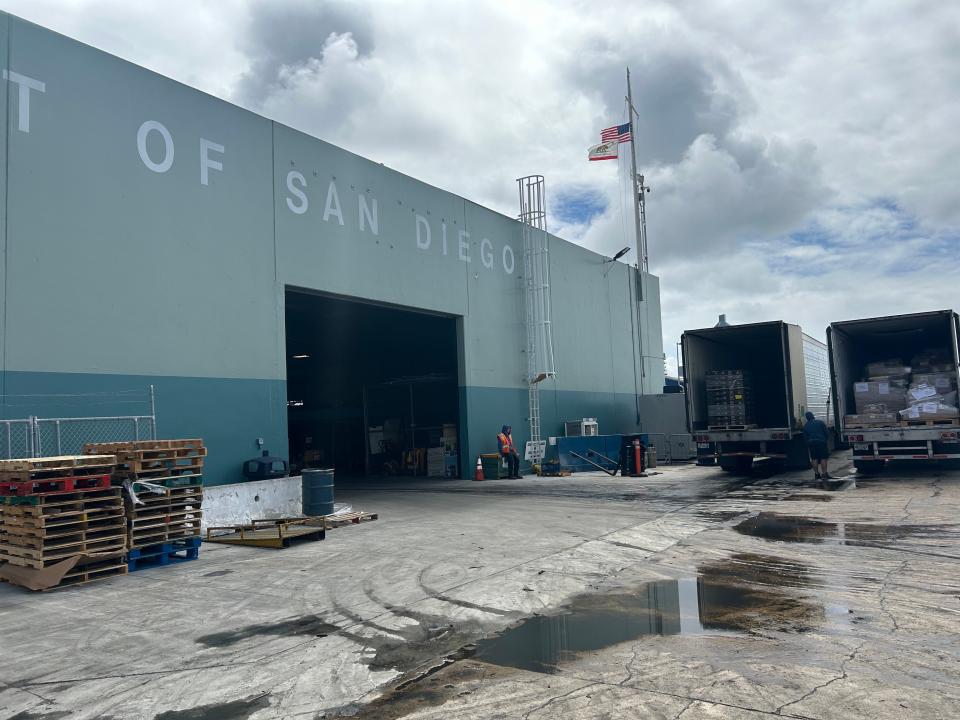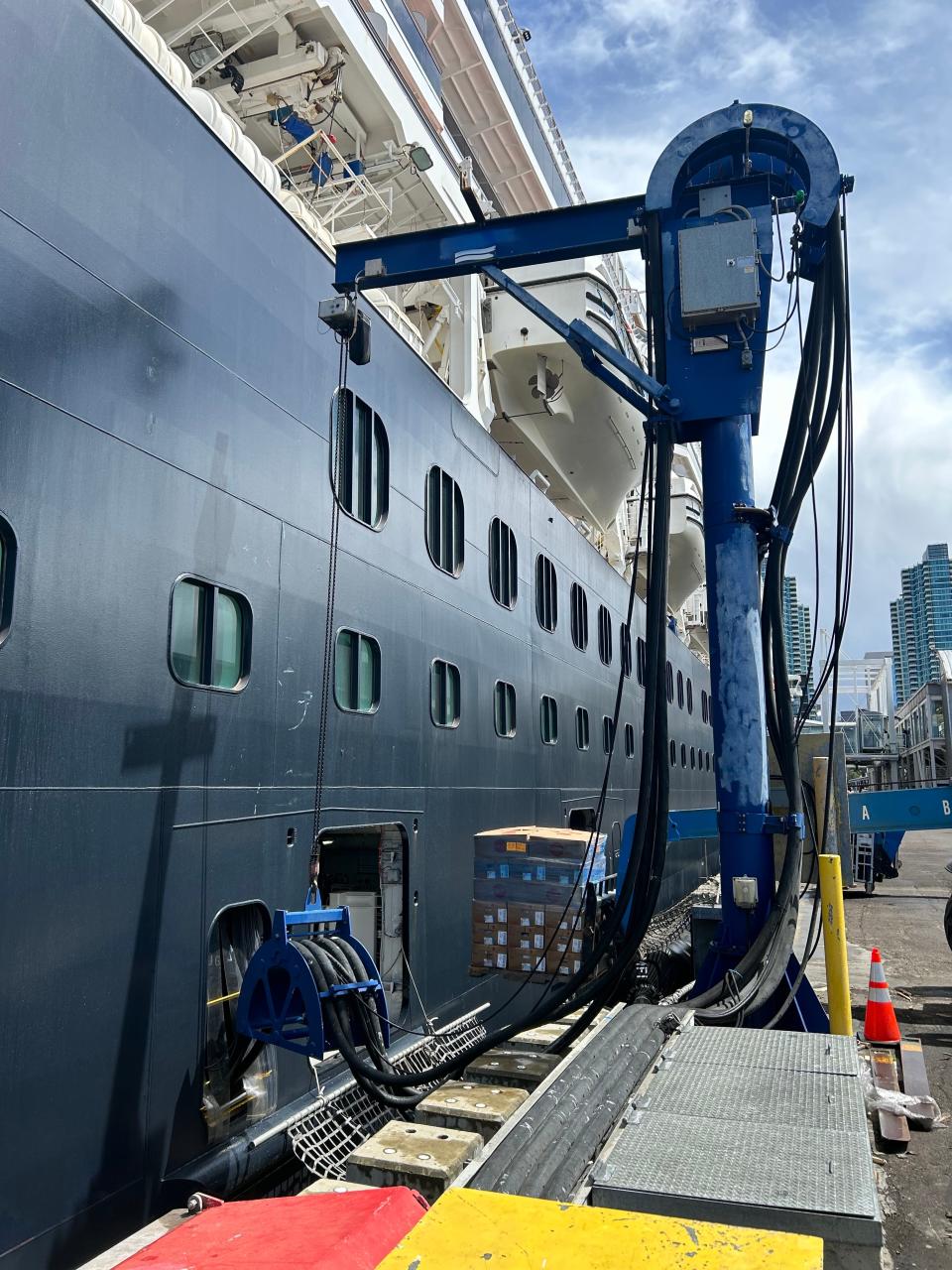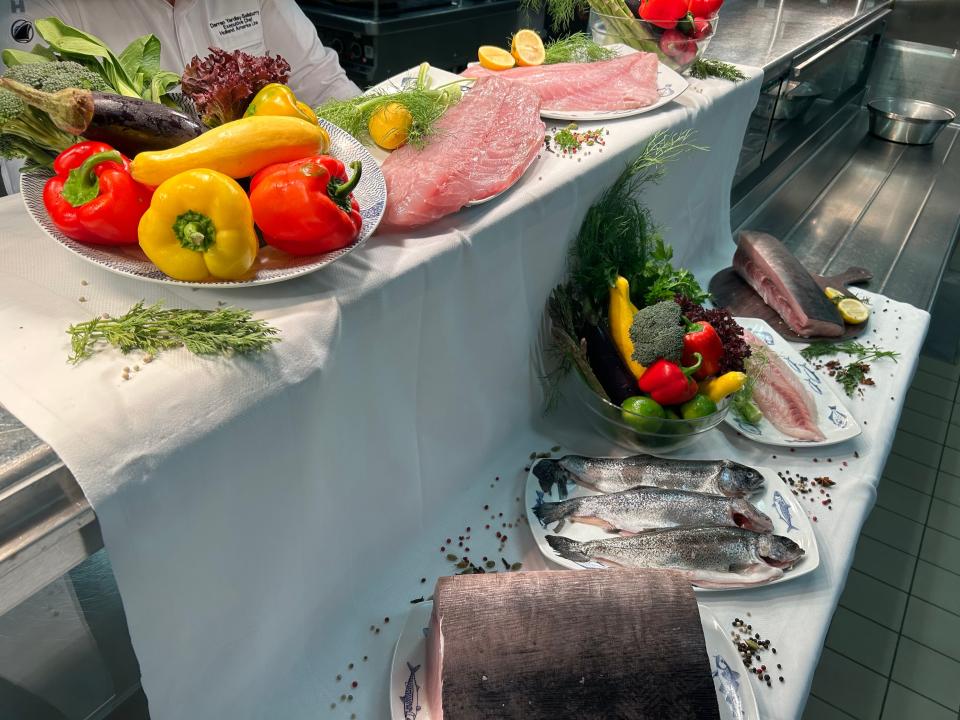Port to plate in 48 hours? How Holland America Line brings fresh fish to guests
The semitruck carrying my dinner backed into its parking spot at the Port of San Diego on a late morning in early April.
Shortly before noon, the vehicle opened to reveal roughly 2,800 pounds of fish that had been caught just days earlier. Workers transferred boxes of mahi-mahi and other seafood from the chilly trailer to a warehouse-like space. The fish was inspected and moved onto an extension lift – think a utility vehicle modeled on Mr. Fantastic – parked near Holland America Line’s Koningsdam ship.
Its mechanical arm reached across the edge of the pier into a square opening toward the vessel’s aft, where it disappeared from view. But by about 7 p.m., a piece of that mahi-mahi was on my plate in the ship’s main dining room.

Prepared with cilantro rice, guajillo chiles, chipotle and tomato, the fish was mild and sweet with a kick from the spicy sauce.

As part of its Global Fresh Fish Program, Holland America brings a wide range of seafood from port to plate within 48 hours across its fleet. Last week, the brand took that a step further, revealing it is the first global cruise line to receive Marine Stewardship Council (MSC) and Aquaculture Stewardship Council (ASC) certifications for more sustainable and responsible seafood sourcing.
USA TODAY got a behind-the-scenes look at how the program works during a recent cruise.
What is Holland America’s fresh fish program?

The cruise line sources fish locally from more than 60 ports around the world. During Koningsdam’s April 5 voyage, the crew picked up the mahi-mahi along with rockfish, swordfish, rainbow trout and sea bass in San Diego.
The 48-hour window applies on most voyages, but on repositioning sailings or crossings, fresh fish may be served over a longer window. In those circumstances, however, the fish is not served under the “port to plate” banner.
On our sailing, they initially loaded enough for five or six days and would later restock. “So out of the 22-day voyage, hopefully, we can do maybe 12 or 13 times fresh fish upstairs and in the dining room,” said executive chef Darran Yardley-Salisbury in a storeroom lined with metallic shelves on one of the vessel’s lower decks.

Michael Stendebach, the line’s vice president of Food & Beverage and Guest Services, told USA TODAY the program was born in response to increasing guest demand for seafood and a desire to make the procurement process more sustainable. He said at least 75% of Holland America passengers order fresh fish once – if not twice – per cruise.
“We were looking into the destinations where we are cruising, like Alaska or the Caribbean, and we wanted to get away from the delivery of (shipping) containers into ports,” Stendebach said. “We wanted to build relationships in the single destinations we are in with suppliers.”
The cruise line previously announced in 2022 that it was certified by Responsible Fisheries Management by serving only fresh, sustainable Alaska seafood on its ships sailing there before scaling up its efforts.
Unlike frozen fish, which is prepared in larger portions – though they vary based on the ship’s size – Stendebach said the fresh fish is cooked “á la minute.”

“The fresh fish is kept cold until the order is coming in and then they start to produce it, so there's no overproduction,” he said. “It's really on the spot, and I think that is the freshest way you can experience the fish.”
During the first few days of the April cruise, other fresh fish dishes included sea bass with lemon butter sauce and tapenade at brasserie Rudi’s Sel de Mer and trout with a bread crumb and cashew crust served in a curry sauce at Asian restaurant Tamarind.
Fresh fish is not available in all ports, though, Yardley-Salisbury said, and the line also still serves seafood that has been frozen (outside of Alaska). The percentage of fresh versus frozen fish varies by sailing.
What kinds of fish are part of the program?
The program features more than 80 kinds of fish, with different selections depending on where the ship is sailing. The Caribbean has options like summer flounder and yellowfin tuna, while Hawaii offers striped marlin and Hawaiian pink snapper, among others (a full list can be found on Holland America’s website).
Getting fresh supplies is easier on some cruises than others. On sailings like ours with many sea days, the kitchen staff has fewer options than in Europe for instance, where vendors are plentiful. "In Europe, it's a little bit like heaven for a chef," said Yardley-Salisbury. "We can go from port to port and we can get the most amazing stuff."

The cruise line denotes which options are fresh on the menus, and will label items that are MSC and ASC certified as well. MSC certifications apply to wild-caught seafood, while ASC certifications are for farmed seafood.
“Overfishing, unregulated fishing, excessive bycatch, these are all things that have a huge impact on the oceans,” said Erika Feller, regional director, Americas at the MSC.
MSC issues certifications to fisheries that meet its sustainability requirements, as well as Chain of Custody certifications that affirm the fish customers are buying comes from a certified fishery. The process is voluntary and the certifications are based on third-party audits.
The fishery certification lasts five years, while the Chain of Custody certification is good for three. Both undergo annual audits to ensure they are maintaining those conditions.

The crew on Koningsdam did a quality check of its own kind.
Yardley-Salisbury and members of the kitchen staff tasted dishes, including fish, before service to make sure the dishes are prepared according to the recipe and the flavor profile is "as it should be." Gathered around a table in a galley, they each grabbed spoon or forkfuls of every dish.
They repeat that process every day before service. "Any alterations that we need to make should only be seasoning issues, temperature issues, volume issues, maybe a little bit of sauce," he said.
What happens to uneaten cruise food?: These lines are working to reduce waste
Does fresh fish cost more?
Fresh fish may be more expensive, but passengers shouldn’t worry about seeing higher fares or food costs as a result. Stendebach said the line is saving money on logistics costs by cutting back on containers “being shipped from A to B.”
“So for that reason, you can spend more money on the product,” he said.
The program and the new certifications help offer guests a user-friendly way to eat more sustainably. Feller said, “the whole idea here is to make it easy for people to find that good choice.”
The reporter on this story received access to this sailing from Holland America Line. USA TODAY maintains editorial control of content.
Nathan Diller is a consumer travel reporter for USA TODAY based in Nashville. You can reach him at [email protected].
This article originally appeared on USA TODAY: How this major cruise line gets fresh fish from port to plate in hours
